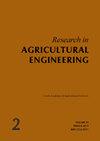Assessment of a submerged membrane bioreactor with composite ceramic filters for cassava wastewater treatment
Q3 Agricultural and Biological Sciences
引用次数: 1
Abstract
Cassava processing activity is characterised by the generation of an enormous quantity of toxic wastewater with detrimental effects on the environment if disposed of without adequate treatment. To alleviate this concern, lab-scaled cylindrical-shaped composite ceramic filters produced from rice husk and clay mixed with equal proportions of activated carbon, kaolin and sherd powder were produced and assessed in a membrane bioreactor. The permeate obtained from the filter with 2.39% rice husks, 0.95% activated carbon, 0.80% kaolin, 0.40% sherd powder and 95.47% clay gave the optimum pollutant removal efficiency. The average removal efficiencies of the chemical oxygen demand (COD), biochemical oxygen demand (BOD), turbidity and hydrogen cyanide (HCN) were 98.32, 78.93, 37.81 and 56.52%, respectively. The pH increased from 3.8 to a maximum value of 6.5. The flux ranges from 0.005 [m3·(m2·d–1)] to a maximum value of 0.108 [m3·(m2·d–1)] obtained for the filter with 1.45% rice husks. The availability of low-cost construction materials and the ease of operation makes the concept a promising option for treating cassava wastewater, however, an optimisation study is required to improve the filter performance and enhance the field applications.复合陶瓷过滤器浸没式膜生物反应器处理木薯废水的评价
木薯加工活动的特点是产生大量有毒废水,如果处理不当,会对环境产生有害影响。为了缓解这种担忧,在膜生物反应器中生产并评估了实验室规模的圆柱形复合陶瓷过滤器,该过滤器由稻壳和粘土与等比例的活性炭、高岭土和碎片粉末混合而成。用2.39%的稻壳、0.95%的活性炭、0.80%的高岭土、0.40%的磨粉和95.47%的粘土过滤得到的渗透物具有最佳的污染物去除效率。化学需氧量(COD)、生化需氧量(BOD)、浊度和氰化氢(HCN)的平均去除率分别为98.32%、78.93%、37.81%和56.52%。pH值从3.8增加到6.5的最大值。对于含有1.45%稻壳的过滤器,通量范围从0.005[m3·(m2·d–1)]到0.108[m3·。低成本建筑材料的可用性和易操作性使该概念成为处理木薯废水的一个有前途的选择,然而,需要进行优化研究,以提高过滤器性能并增强现场应用。
本文章由计算机程序翻译,如有差异,请以英文原文为准。
求助全文
约1分钟内获得全文
求助全文
来源期刊

Research in Agricultural Engineering
Engineering, agriculture-
CiteScore
1.40
自引率
0.00%
发文量
21
审稿时长
24 weeks
期刊介绍:
Original scientific papers, short communications, information, and studies covering all areas of agricultural engineering, agricultural technology, processing of agricultural products, countryside buildings and related problems from ecology, energetics, economy, ergonomy and applied physics and chemistry. Papers are published in English.
 求助内容:
求助内容: 应助结果提醒方式:
应助结果提醒方式:


